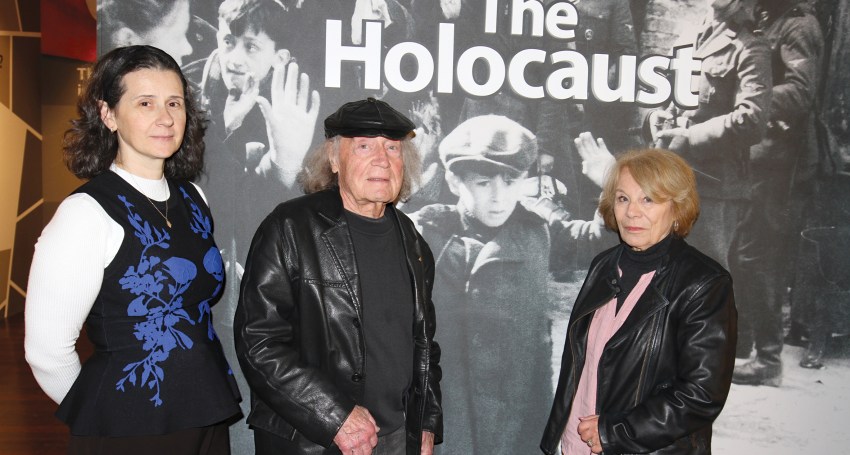Holocaust museum a symbol of hope
News
A Jewish museum in a Catholic building might seem incongruous but for 87-year-old Holocaust survivor Andrew Steiner it’s a dream come true.

Through the annual commemoration of the Remembrance of the Shoah initiated by Archbishop Philip Wilson, Mr Steiner began discussions with the Adelaide Archdiocese about establishing a Holocaust museum in Fennescey House, Wakefield St.
While Sydney and Melbourne have well-established Holocaust museums, Adelaide has a much smaller Jewish community. In recent times Perth and Brisbane have received capital funding to develop museums.
“It’s absolutely wondrous, one has to believe in miracles,” Mr Steiner told The Southern Cross ahead of the museum’s official opening on November 9.
Advertisement
“I didn’t have much support, there were a lot of obstacles to overcome, but I specifically want to thank Archbishop Wilson who very generously gave us this wonderful heritage building.
“I feel very blessed to see it come together, it’s really a dream, a vision and I’m very humbled by the whole experience.”
A capital campaign commenced in March 2017 with a generous lead pledge from Gandel Philanthropy that in turn attracted other philanthropic and private donors. Visiting the Adelaide Holocaust Museum and Andrew Steiner Education Centre (AHMSEC) recently, Treasurer Josh Frydenberg announced a $2.5 millon capital grant to continue to develop the site.
AHMSEC chair Nicola Zukerman said “the additional capital investment in the museum as an educational resource will enable AHMSEC to be a centre of excellence and a primary source of Holocasut education in South Australian schools”.
Despite the recent capital investment announcement the museum will still rely on philanthropic donations from organisations and individuals for operational needs.
AHMSEC is located on the ground floor of Fennescey House and has three main gallery spaces, the largest of which will be named the Anne Frank Gallery which has been endowed by John and Pauline Gandel AC.
Advertisement
Another gallery features the stories of six local Holocaust survivors, alongside an education centre for secondary students. Several touring exhibitions are already planned and a smaller space will feature a collection of works known as the Holocaust Series by the late Franz Kempf AM.
Mr Steiner is a local artist who has been educating students in SA for the past three decades about the history of the Holocaust. Born in Hungary, he was forced into hiding with his family after the Nazis attacked Budapest in 1944. Eleven members of Mr Steiner’s extended family were executed by the Nazis. Narrowly escaping this fate he and his sister, mother and father migrated to Australia in 1948.
Mr Steiner said it was only through education that “we can work towards a better and more compassionate world”.
Another Holocaust survivor, Eva Temple, who also talks to students about her experience, said the museum would be an “eye opener to a lot of people about what really did happen and about Jewish people in general”.
She also said it was important to connect with other religions and communities: “The more you can understand one another’s differences, the better. You don’t have to believe what other people believe but at least have the decency to listen and to accept and respect other people.”
Related Story
Boost for new Holocaust museum
Kathy Baykitch, director of AHMSEC, said the location of the museum in the heart of the city, adjacent to the Cathedral, would “reconnect” the Jewish community which had a presence in Synagogue Place until the synagogue closed in 1990.
“By reconnecting the Jewish community to the city centre in a way that’s meaningful by telling and sharing the stories of the Holocaust through survivors like Andrew and Eva we can really embed the message of ‘never again’ for now and for future generations,” she said.
“Given we’ve all been living in a fragile world managing the COVID-19 pandemic and global lock downs, it’s in these very moments that warning signs often appear such as prejudice and a lack of understanding of other people.
“The fact that we are opening this institution with the incredible continued support of the Catholic Archdiocese on a significant evening that marks the commemoration of Kristallnacht, the Night of Broken Glass, is a poignant reminder of the importance of this museum.”
The inhouse education program is directed at Year 10 students who study the Holocaust as part of the Australian curriculum and is based on the pedagogy of Yad Vashem, the national Holocaust memorial in Jerusalem, where the names of four million of the six million Holocaust victims are so far recorded.
The museum will be open Tuesday – Thursday and Sundays. Visit www.ahmsec.org.au for more information. Enquiries for student visits should be emailed to admin@ahmsec.org.au








Comments
Show comments Hide comments